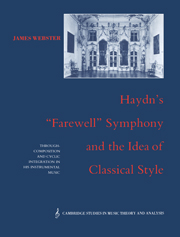 Haydn's 'Farewell' Symphony and the Idea of Classical Style
Haydn's 'Farewell' Symphony and the Idea of Classical Style Book contents
- Frontmatter
- Contents
- Foreword by Ian Bent
- Preface
- Author's note
- List of abbreviations
- Introduction
- PART I THE FAREWELL SYMPHONY
- PART II CYCLIC ORGANIZATION IN HAYDN'S INSTRUMENTAL MUSIC
- 5 Progressive form and the rhetoric of instability
- 6 Integration of the cycle
- 7 Extramusical associations
- 8 Individual compositions
- Historiographical conclusion: Haydn's maturity and “Classical style”
- Bibliography
- Index
8 - Individual compositions
Published online by Cambridge University Press: 28 January 2010
- Frontmatter
- Contents
- Foreword by Ian Bent
- Preface
- Author's note
- List of abbreviations
- Introduction
- PART I THE FAREWELL SYMPHONY
- PART II CYCLIC ORGANIZATION IN HAYDN'S INSTRUMENTAL MUSIC
- 5 Progressive form and the rhetoric of instability
- 6 Integration of the cycle
- 7 Extramusical associations
- 8 Individual compositions
- Historiographical conclusion: Haydn's maturity and “Classical style”
- Bibliography
- Index
Summary
Having topically surveyed Haydn's principal techniques of through-composition – progressive form, cyclic integration, extramusical associations – we now return to individual compositions. In this chapter we examine a dozen works which are to a greater or lesser degree through-composed: Symphonies 15, 25, 46, 49, 99, and 103; the string quartets Opp. 20 No. 2, 50 No. 4, 54 No. 2, and 74 No. 3; the keyboard sonata Hob. XVI:30; and the piano trio Hob. XV:26 (Others could be added; some of these have been described briefly in Chapters 6 and 7.) These works are varied by genre, date (two very early, one 1768, two 1772, one mid-1770s, two late 1780s, four 1793–95), and mode (eight in the major, four in minor); they also vary as to their likelihood of having had tangible extramusical associations. This broad distribution not only confirms the status of through-composition as a normal (if not necessarily common) aspect of Haydn's art, but disproves any notion that his interest in it might have been restricted to a single genre, period, or stylistic orientation – for example, to overtly exceptional “Sturm und Drang” works such as the Farewell Symphony.
On the other hand, cyclic integration must not be made a criterion of value. The Farewell and Symphony 46 (see below) are not among Haydn's greatest works because they are through-composed; their tonal and thematic continuity and manipulations of genrepatterns are aspects of their particular genius, not signs of special quality.
- Type
- Chapter
- Information
- Haydn's 'Farewell' Symphony and the Idea of Classical StyleThrough-Composition and Cyclic Integration in his Instrumental Music, pp. 250 - 334Publisher: Cambridge University PressPrint publication year: 1991
